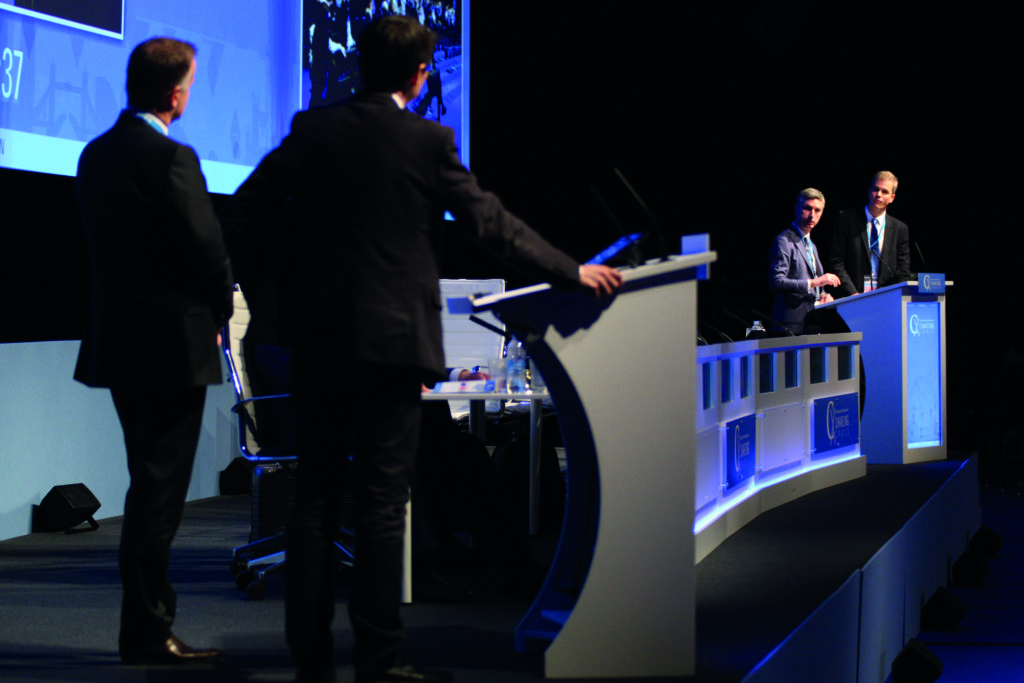
At one of the 2016 Charing Cross (CX 2016; 26–29 April, London, UK) Great Debates, a small majority of the audience (53%) voted against the motion “In chronic type B dissection, there is no place for false lumen embolisation—true lumen TEVAR is preferred”. The voting signalled victory for Fabrizio Fanelli, Rome, Italy, and Tilo Kölbel, Hamburg, Germany, who cleverly unpicked the motion to show that if false lumen embolisation was used even in select cases, it would go against the motion. Peter Mossop, Melbourne, Australia and Stephan Haulon, Lille, France, argued for the motion, and made the case that false lumen embolisation had no place in chronic type B dissection.
False lumen embolisation is a relatively new endovascular strategy that seeks to occlude the false lumen and stop flow with the use of coils, plugs, liquid embolics or occluders. The use of stent grafts to achieve the same result is more common and there is more evidence in the medical literature on techniques that use the latter devices.
All participants in the Great Debate agreed that chronic aortic dissection is a challenging disease that requires individualised treatment approaches. They also noted that false lumen perfusion and pressure appear to count as a risk factor for aneurysm formation and complications in chronic aortic dissection.
The winning team began by explaining that false lumen embolisation is needed in chronic type B dissection because the aorta fails to remodel after TEVAR in a third of cases, and noted that this might be due to perfusion and the pressure remaining unchanged in the false lumen. Intercostals originating from the false lumen and false lumen back flow to intercostals also contribute to the need for embolisation, they said.
In their presentation, the winning duo succeeded in highlighting to the audience instances in which their opponents in the Great Debate had reported using false lumen embolisation, thus showing that this went against the motion which suggests that the technique has no place, or should never be used, in the treatment paradigm.
They then based their arguments on false lumen embolisation being a simpler, safer procedure that has shorter procedure times than alternative techniques to thrombose the lumen such as the use of fenestrated endografts. Fanelli and Kölbel also alluded to the fact that rates of complications such as spinal cord ischaemia were high with fenestrated devices; that these were costly; and the techniques complex, meaning that they cannot be widely offered to patients.
Mossop and Haulon argued that aortic dissection, in all its forms, requires a flexible approach with true lumen reconstruction as the primary aim. They also emphasised that there are limited data, and no long-term data, on embolisation outcomes for false lumen thrombosis.
Mossop and Haulon maintained that a staged stent and endograft technology and techniques such as STABILISE (Stent and balloon induced intimal disruption and relamination) have shown encouraging results in a small series with no procedural complications or related early mortality or morbidity and with follow-up to five years showing no evidence of adverse aortic remodelling.
The team noted that partial flow lumen thrombosis is often cited as a predictor of poor long-term prognosis. “However not all perfused false lumens require embolisation. Partial thrombosis is an indicator of flow stagnation and may be part of a natural progression to complete thrombosis,” Mossop said.
The team argued that monitoring after TEVAR is key to select the minority of patients with persistent false lumen flow and higher risk morphology or growth who may benefit from the application of embolotherapy.
“Embolisation devices may not be designed for use in dissection, or are unproven. A focus on occlusive therapy within the false lumen misses the point of dealing with the pathophysiology—that re-entry flow and inadequate repair of the true lumen is the primary reason for ongoing false lumen degeneration,” Mossop said.
Tara Mastracci, London, UK, previously spoke on the legitimacy of embolisation in the false lumen.
“The false lumen is a very interesting place that exists only in the diseased state and somehow in the last couple of years, as aortic interventionalists, we have come to look at it as the place where we want to find the cure. So it is interesting that we are now focusing on actually placing things in the false lumen in order to hopefully change the course of the disease,” she said.
Mastracci commented that her “impression of our goals of treatment for type B dissection is now no longer so much about survival”.
“It is also no longer about decreasing reintervention because I firmly believe that this is a progressive disease that likely needs stages of multiple intervention, but most importantly we are seeking a treatment that changes the natural history of the disease,” she added.
“The concept of false lumen thrombosis, or aortic remodelling, has been around for a while,” noted Mastracci. She also alluded to the fact that false lumen thrombosis was very difficult to accurately quantify on cross-sectional imaging.
“The real question is: Does false lumen thrombosis occur in aortas that are selectively predisposed to remodelling or are we actually promoting remodelling if we perform false lumen thrombosis?
“If you ask me about the legitimacy of placing embolic materials in the false lumen, it probably serves its purpose in terms of causing clot but whether or not it serves its purpose in altering the natural history of the disease remains to be proven. I think false lumen thrombosis is definitely correlated with aortic remodelling but causation is certainly not something I have seen evidence of in the literature. The methods for causing thrombosis with embolic material have not changed the history of disease in the literature that I have been able to find,” she concluded.













